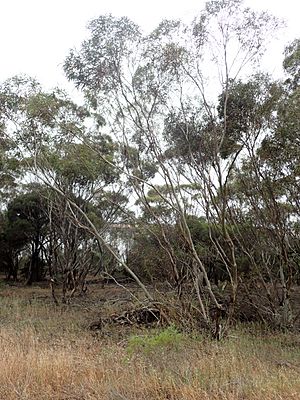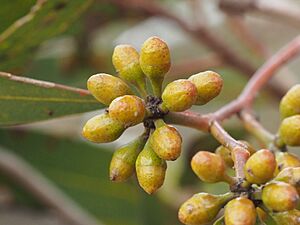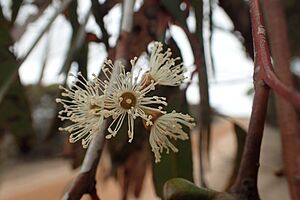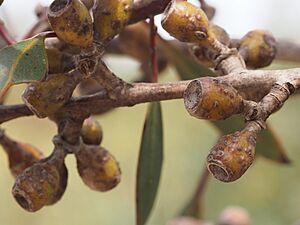Hopetoun mallee facts for kids
Quick facts for kids Hopetoun mallee |
|
|---|---|
 |
|
| Eucalyptus leptocalyx growing west of Scaddan | |
| Scientific classification | |
| Genus: |
Eucalyptus
|
| Species: |
leptocalyx
|
The Eucalyptus leptocalyx, also known as the Hopetoun mallee, is a special type of mallee tree. It is only found in a specific area along the south coast of Western Australia. This unique plant has smooth bark and leaves shaped like a spear.
You can spot its creamy white flowers growing in groups of nine to fifteen. After the flowers, it produces fruit that looks like a small barrel or cylinder.
Contents
About the Hopetoun Mallee
The Hopetoun mallee is a type of small tree or large shrub. It usually grows to be about 2 to 8 meters (6.5 to 26 feet) tall. This plant has smooth bark that is brownish with hints of light pink.
Young plants and new shoots have leaves that are arranged in a special way. These leaves are egg-shaped, about 50 to 85 millimeters (2 to 3.3 inches) long and 30 to 45 millimeters (1.2 to 1.8 inches) wide. They also have a small stem called a petiole.
Leaves, Flowers, and Fruit
The adult leaves of the Hopetoun mallee are shiny green on both sides. They are shaped like a spear, measuring 75 to 120 millimeters (3 to 4.7 inches) long. These leaves are 10 to 28 millimeters (0.4 to 1.1 inches) wide, with a petiole 12 to 35 millimeters (0.5 to 1.4 inches) long.
Its flower buds grow in groups of nine to fifteen. Each group is on a stem called a peduncle, which is 5 to 15 millimeters (0.2 to 0.6 inches) long. The individual buds are cylindrical, about 8 to 13 millimeters (0.3 to 0.5 inches) long. They are 4 to 6 millimeters (0.16 to 0.24 inches) wide.
The flowers are creamy white and bloom from September to March. After flowering, the plant produces a woody fruit. This fruit is shaped like a barrel or cylinder, 7 to 12 millimeters (0.3 to 0.5 inches) long and 6 to 8 millimeters (0.24 to 0.31 inches) wide.
Discovery and Naming
The Hopetoun mallee was first officially described in 1934. A botanist named William Blakely wrote about it. He used a plant sample collected near Hopetoun in 1909 by Joseph Maiden. Blakely published his description in his book, "A Key to the Eucalypts."
The scientific name leptocalyx comes from ancient Greek words. Leptos means "thin" or "slender," and calyx means "cup."
Where it Grows
The Hopetoun mallee grows in areas near the coast of Western Australia. You can find it between the Fitzgerald River National Park and Israelite Bay. It prefers to grow in gravelly, sandy-clay soils.
Conservation Status
The Western Australian Government's Department of Parks and Wildlife has checked on this mallee. They have classified it as "not threatened." This means it is not currently at risk of disappearing.




